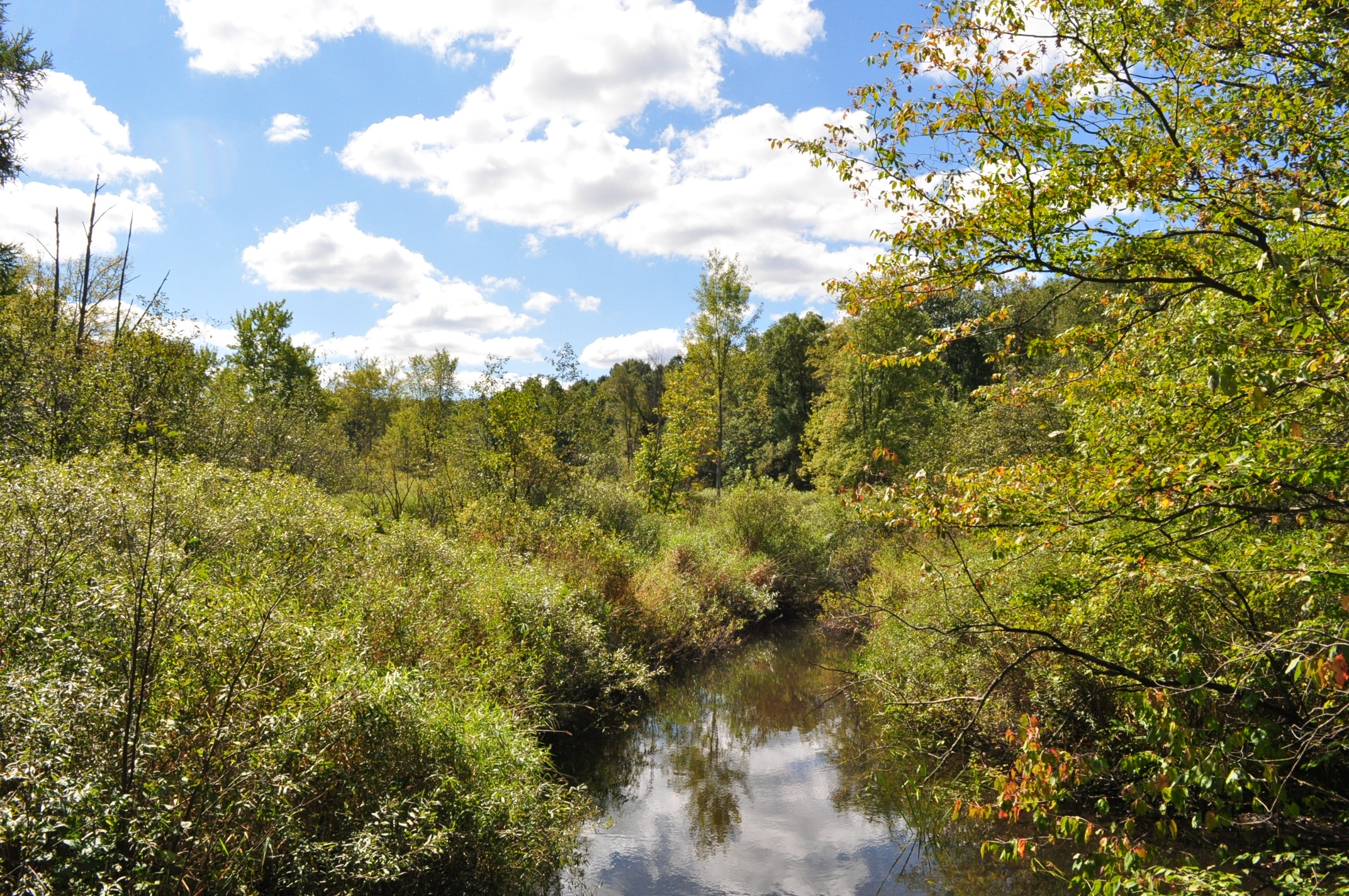Amenities: Parking. Social trails. No restrooms.
This hidden gem in Barry County is home to many breeding forest birds, and you might just spot that Acadian Flycatcher or Scarlet Tanager that has been eluding you while visiting. Ronald H. Warner Sanctuary is located in an area of glacial moraines, with rounded ridges, seasonal ponds, a stream, and a lake. Its 108 acres are primarily wooded, with old-growth beech, oak, and tulip trees. The sanctuary is botanically diverse and is home to numerous species of plants that are critical for the health of the local habitat. The adjacent Barry State Game Area provides additional landscape-scale habitat and connectivity, as well as the nearby Otis Farm Bird Sanctuary. This area in Barry County is known for breeding Cerulean Warblers.
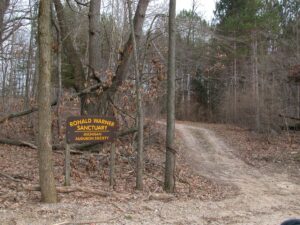 Directions
Directions
Location: 2500 Erway Rd., Hastings, MI 49508
From Hastings, take M-43 west five miles to Goodwill Road and turn west. Follow the signs and turn right onto Erway Road. Drive 2.2 miles to the parking lot on the east side, just past the Boys and Girls Club drive.
Parking: Two to three vehicles may park in the gravel pull-out area.
GPS coordinates of parking area: 42.62072, -85.39637
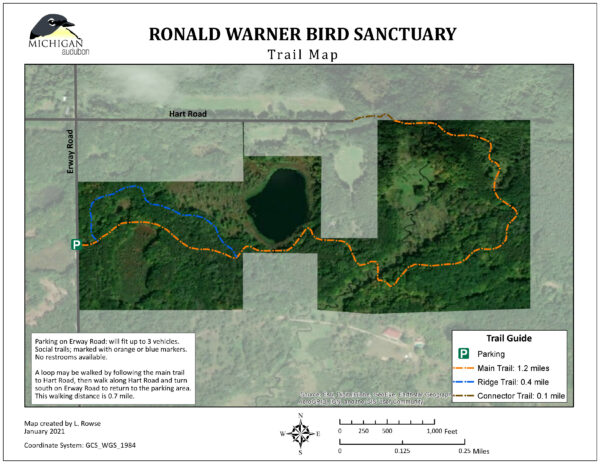 Trails
Trails
The main trail through Ronald H. Warner Sanctuary is marked with orange diamond markers and posts and is about 1.3 miles in length, beginning at the parking area on Erway Road and ending on Hart Road. Visitors may walk a loop by following the main trail to Hart Road, and then walking west on Hart Road to the intersection with Erway Road, and walking south on Erway Road to return to the parking area. This walk along the roads adds approximately 0.7 miles to the main trail.
A newly created trail, the Ridge Trail, is marked with blue diamond markers. This trail follows a ridge in the northwest corner of the sanctuary and passes by an overlook of Warner Lake. The Ridge Trail is 0.4 miles in length.
Both trail surfaces are packed dirt; take care to watch for roots, rocks, or other tripping hazards. There are several short boardwalks along the trails to bypass seasonally flooded or wetland areas. The trails have some short but steep hills. Walking and snowshoeing are great activities at this sanctuary, which is open from dawn to dusk daily, year-round. Dogs are allowed on-leash only.
Download the trail map here.
Would you like to take a tour of the sanctuary? Check out this video made by volunteers Maeve, Anne, and Doug Klein!
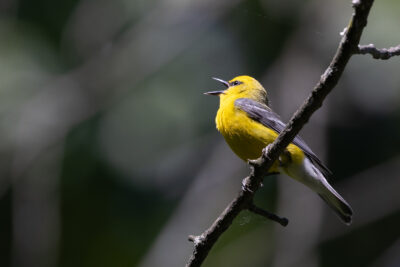
Blue-winged Warbler at Ronald H. Warner Sanctuary. Photo by Sherman W. Garnett
Bird Species of Note
To date, 124 bird species have been recorded at this sanctuary. It’s a great place to hear Acadian Flycatchers throughout the breeding season, as well as Scarlet Tanager, Yellow-billed Cuckoo, Yellow-throated Vireo, and Eastern Wood-Pewee. This past winter and spring 2021, Common Raven and Evening Grosbeak were added to the bird list. During spring or fall migration, you might find a big flock of Rusty Blackbirds or Common Grackles, or many different species of warblers, flycatchers, thrushes, and many more!
If you would like to contribute to the public bird list for Ronald H. Warner Sanctuary, please use the eBird hotspot “Warner Sanctuary” and enter birds you see or hear while visiting at https://ebird.org/hotspot/L492836.
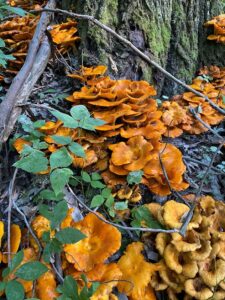
Photo by Doug Klein
Natural Communities
In the mid-1800s, this area of Barry County was extensively cleared and farmed. About 50–70 years ago, Mr. Warner planted several pine plantations in previously cleared areas.
Habitats within the Ronald H. Warner Sanctuary and the adjacent Barry State Game Area have rebounded from clearcutting and other human modifications. Much of the habitat you see at the sanctuary today is mature beech and oak-hickory forest. Historically, the ecological communities of this area may have included oak-hickory forest, hardwood swamp, and emergent wetland or shrub swamp along Glass Creek.
Warner Lake is a 10-acre lake with bog tendencies. The entire lake is ringed with submerged or emergent wetland vegetation. There is a small outlet that flows to Glass Creek. No fishing is allowed.
The vegetation found at the sanctuary is very diverse and includes some sensitive or rare species.
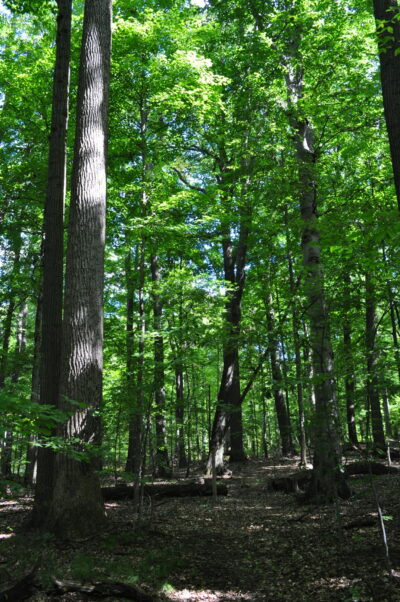 History of Ronald H. Warner Sanctuary
History of Ronald H. Warner Sanctuary
Ronald “Pop” Warner donated the first parcel to Michigan Audubon in 1972, and subsequent parcels were donated by his widow, Marie Warner, in 1979 and 1986.
Pre-European History:
In a tradition shared by all three tribes, the Potawatomi came from the northeast with the Ottawa and Ojibwa to the eastern shore of Lake Huron. This is believed to have happened sometime around 1400 after the North American climate became colder. The Ottawa remained near the French River and on Manitoulin and the other islands in Lake Huron, but the Potawatomi and Ojibwa continued north along the shoreline until they reached Sault Ste. Marie. About 1500, the Potawatomi crossed over and settled in the northern third of Lower Michigan. Although separated, the three related tribes remembered their earlier alliance and referred to each other as the “three brothers.” As the keepers of the council fire of this old alliance, the Potawatomi were called “potawatomink” or “people of the place of fire.”
Although they did not meet until later, the French first learned of the Potawatomi on the far side of the “Great Freshwater Sea” when the Huron mentioned them to Champlain in 1615 during his first visit to their villages. There is a chance Jean Nicollet may have met the Potawatomi in 1634 while en route to Green Bay to arrange a truce between the Winnebago and the Ottawa and Huron.
Potawatomies had summer camps on the Thornapple River and undoubtedly traversed in the area along the Glass Creek on summer hunting parties.
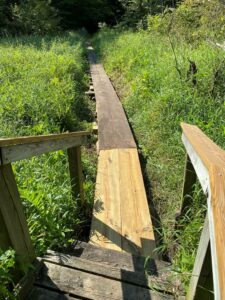 Projects/Volunteer Opportunities
Projects/Volunteer Opportunities
Sanctuary steward volunteers help keep trails cleared of fallen branches and logs, maintain boardwalks, trim back grasses, and check boundary signs. Volunteers may also help us inventory the sanctuary by doing seasonal bird surveys, flora surveys, monitoring and removing invasive species, and monitoring vernal pools.
In the 2020-2021 winter, volunteers helped install a new Eastern Screech-Owl nest box and a couple of Eastern Bluebird boxes. Volunteers also rebuilt the boardwalk crossing Glass Creek and created the new Ridge Trail loop. New benches were installed at great spots along the trail to sit and observe birds and nature or rest your legs!
Learn more about volunteering and fill out a volunteer application form here: https://www.michiganaudubon.org/get-involved/volunteer/
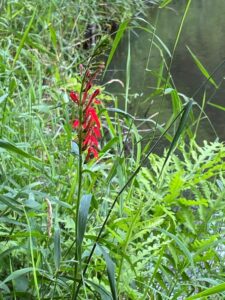
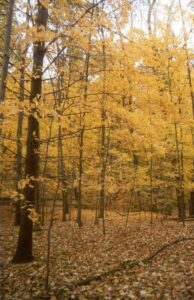
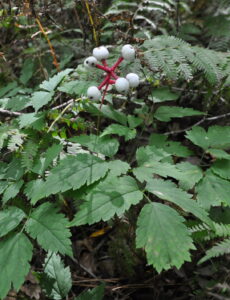
Michigan Audubon maintains a statewide network of bird sanctuaries. The network consists of 18 sanctuary properties that together total nearly 4,000 acres. The habitats we protect and steward include rivers, lakes, marshes, bogs, fens, grasslands, hardwoods, and northern conifer forests. Each property plays a critical role in protecting Michigan native plants and animals, including both endangered and threatened species.
Learn more about Michigan Audubon bird sanctuaries at michiganaudubon.org/our-conservation-impact/bird-sanctuaries.

